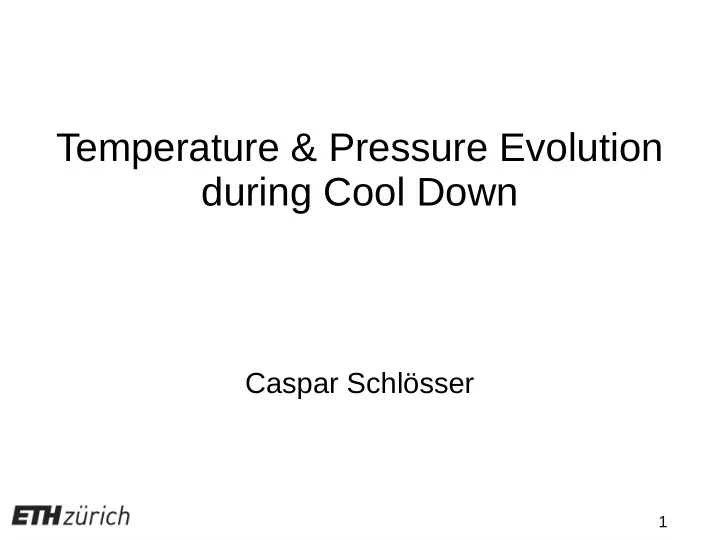

Temperature & Pressure Evolution during Cool Down Caspar Schlösser 1
Outline ● Heat input & temperature evolution during cool down ● Temperature evolution in Insulation ● Temperatures and pressures in SGFT chimneys ● Pressures in insulation & tank during cool down 2
Heat input 14.95 W/K × ΔT – 2256 W 982 W 3
Temperature evolution during cool down Assuming the internal energy of Argon in tank is proportional to its temperature, we get: With the following solution: Thus ΔT → 155 K for t → ∞ and T tank → 138 K ( T LAr = 87 K ) 4
Temperature evolution during cool down E Gas outlet S N Manhole W 16 temperature sensors in 4 groups of 4 each 5
Temperature evolution during cool down Fairly uniform temperature across CRP with differences between sensors < 5 K 6
Temperature evolution during cool down Exponential fit of ΔT = T lab – T tank during cool down Equation from heat input considerations: to be compared with parameters from exp. fit: 17.8 W/K 1216 W 7
Temperature sensors in Insulation ● 44 sensors total ● arranged in 3 layers on all 4 sides and bottom Outer Tank Membrane closing Insulation Membrane 8
Insulation temperature before cool down 9
Insulation temperature during cool down 10
Insulation temperature during cool down Floor sensor 11
Insulation temperature during cool down Bottom and floor sensors 12
Insulation temperature evolution during cool down 13
Temperature sensors in SGFTs ● 2 thermocouple sensors in all SGFT chimneys ● one on top, one on bottom S N SGFT1 SGFT2 SGFT3 SGFT4 14
Thermocouples in SGFT chimneys ● 4 SGFT chimneys with 3 TCs each ● Designed to measure absolute temperature on bottom and differential temperature between top/bottom ● However, we measure an absolute temperature on both ● Live wire of bottom or top TC grounded → measure T instead of ∆T 1 live wire grounded 15
Thermocouples in SGFT chimneys top/bottom anti-correlated During cool down Before cool down 16
Thermocouples in SGFT chimneys Polarity switched TC temperature after reversal of polarity 17
Differential pressures SGFT chimneys ● SGFT chimneys have gas volume isolated from tank & atmosphere ● filled with N 2 ● relative pressure sensor to atmosphere in each chimney SGFT4 SGFT3 SGFT2 SGFT1 18
Differential pressures SGFT chimneys Differential pressure before cool down ● SGFTs were filled with N2 at a slight overpressure wrt. atm ● Differential pressure anti-correlated with atm 19
Absolute pressures SGFT chimneys Absolute pressure before cool down Stays roughly constant & above atmospheric pressure → No leaks in chimneys 20
Absolute pressures SGFT chimneys Absolute pressure Strongly correlated with Temperaure during cool down Pressure drops below atmosphere and warm up 21
Absolute pressures SGFT chimneys Strongly correlated with Temperaure Pressure drops below atmosphere ● Pressure in chimneys Absolute pressure during cool down needs to be regulated and warm up during cool down ● 4 SGFTs for 3x1x1 ● automated system for 6x6x6 required 22
Absolute pressures in Tank/Insulation & atm 2 absolute pressure sensors in insulation 23
Differential pressures Tank/IS, Tank/atm ● 1 relative pressure sensor: P tank – P atm ● 1 differential pressure sensor: P tank – P IS ● range of old sensors: -20 +20 mbar ● new sensors have been installed ● range of new sensors: -50 +50 mbar out of range during cool down New sensors installed with ranges of -50 +50 mbar 24
Conclusion ● Temperature evolution during cool down is described by an exponential function ● Insulation temperatures need to be checked continuously during cool down ● Care has to be taken when installing thermocouples in chimneys ● Pressures in chimneys need to be adjusted during cool down ● Ranges of pressure sensors need to be checked before installation 25
Recommend
More recommend